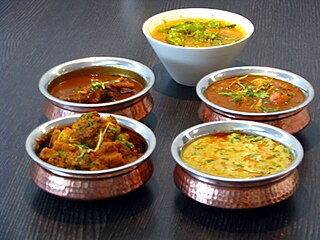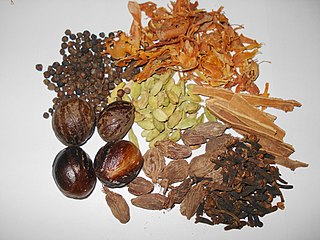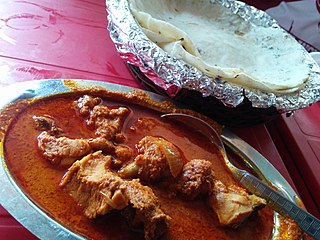
A curry is a dish with a sauce seasoned with spices, mainly associated with South Asian cuisine. In southern India, leaves from the curry tree may be included.

A chutney is a spread typically associated with cuisines of the Indian subcontinent. Chutneys are made in a wide variety of forms, such as a tomato relish, a ground peanut garnish, yogurt or curd, cucumber, spicy coconut, spicy onion or mint dipping sauce.

Garam masala [from Hindustani گرم مصالحہ/गरम मसाला ] is a blend of ground spices originating from India. It is common in Indian, Pakistani, Nepalese, Bangladeshi, Sri Lankan and Caribbean cuisines. It is used alone or with other seasonings.

Spice mixes are blended spices or herbs. When a certain combination of herbs or spices is called for in a recipe, it is convenient to blend these ingredients beforehand. Blends such as chili powder, curry powder, herbes de Provence, garlic salt, and other seasoned salts are traditionally sold pre-made by grocers, and sometimes baking blends such as pumpkin pie spice are also available. These spice mixes are also easily made by the home cook for later use.

The curry tree, Murraya koenigii or Bergera koenigii, is a tropical and sub-tropical tree in the family Rutaceae, native to Asia. The plant is also sometimes called sweet neem, though M. koenigii is in a different family to neem, Azadirachta indica, which is in the related family Meliaceae.

Chili powder is the dried, pulverized fruit of one or more varieties of chili pepper, sometimes with the addition of other spices. It is used as a spice to add pungency (piquancy) and flavor to culinary dishes. In American English, the spelling is usually "chili"; in British English, "chilli" is used consistently.

Sofrito, sofregit, soffritto, or refogado is a basic preparation in Mediterranean, Latin American, Spanish, Italian and Portuguese cooking. It typically consists of aromatic ingredients cut into small pieces and sautéed or braised in cooking oil for a long period of time over a low heat.

Onion powder is dehydrated, ground onion that is commonly used as a seasoning. It is a common ingredient in seasoned salt and spice mixes, such as beau monde seasoning. Some varieties are prepared using toasted onion. White, yellow and red onions may be used. Onion powder is a commercially prepared food product that has several culinary uses. Onion powder can also be homemade.
Odia cuisine is the cuisine of the Indian state of Odisha. Compared to other regional Indian cuisines, Odia cuisine uses less oil and is less spicy, while nonetheless remaining flavourful. Rice is the staple food of this region. Mustard oil is used in some dishes as the cooking medium, but ghee is preferred in temples. In old times, food was traditionally served on copper plates or disposable plates made of sal leaves.

Hoysala Karnataka Brahmins are a community of Smarta Brahmins originating in the Hoysala Empire. The empire ruled most of what is now Karnataka between the 10th and the 14th centuries.

Jollof, or jollofrice, is a rice dish from West Africa. The dish is typically made with long-grain rice, tomatoes, onions, spices, vegetables and meat in a single pot, although its ingredients and preparation methods vary across different regions.

Madras curry or Madras sauce is a fairly hot curry sauce, orange in colour and with heavy use of chili powder. Raita is often used as an accompaniment to the dish.

Batata vada is a popular vegetarian fast food dish from the Indian state of Maharashtra. The dish consists of a mashed potato patty coated with chick pea flour, which is then deep-fried and served hot with chutney. The vada is typically around two or three inch in diameter. Across different regions of India, this dish is also known as aloo bonda, aloo vada, batata bonda, potato bonda and potato vada.

Chicken curry is a dish originating from the Indian subcontinent. It is common in the Indian subcontinent, Southeast Asia, Great Britain, Caribbean, and Japan. A typical curry from the Indian subcontinent consists of chicken stewed in an onion- and tomato-based sauce, flavoured with ginger, garlic, tomato puree, chilli peppers and a variety of spices, often including turmeric, cumin, coriander, cinnamon, and cardamom. Outside of South Asia, chicken curry is often made with a pre-made spice mixture known as curry powder.

Nigerian cuisine consists of dishes or food items from the hundreds of ethnic groups that comprise Nigeria. Like other West African cuisines, it uses spices and herbs with palm or groundnut oil to create deeply flavored sauces and soups.

Tunisian cuisine, the cuisine of Tunisia, consists of the cooking traditions, ingredients, recipes and techniques developed in Tunisia since antiquity. It is mainly a blend of Mediterranean and native Punics-Berber cuisine. Historically, Tunisian cuisine influenced many cultures and nations like Italians, Andalusians, French and Arabs.

Ghugni or ghuguni or guguni is a curry made of peas or chickpeas. Different variations of the dish use different types of peas or chickpeas, such as black gram, green peas, or white peas. It is a snack native to the Indian subcontinent, especially popular in Eastern India, Northeast India and in Bangladesh.

Malaysian Indian cuisine, or the cooking of the ethnic Indian communities in Malaysia, consists of adaptations of authentic dishes from India, as well as original creations inspired by the diverse food culture of Malaysia. Because the vast majority of Malaysia's Indian community are of South Indian descent, and are mostly ethnic Tamils who are descendants of immigrants from a historical region which consists of the modern Indian state of Tamil Nadu and Sri Lanka's Northern Province, much of Malaysian Indian cuisine is predominantly South Indian inspired in character and taste. A typical Malaysian Indian dish is likely to be redolent with curry leaves, whole and powdered spice, and contains fresh coconut in various forms. Ghee is still widely used for cooking, although vegetable oils and refined palm oils are now commonplace in home kitchens. Before a meal it is customary to wash hands as cutlery is often not used while eating, with the exception of a serving spoon for each respective dish.

Bumbu is the Indonesian word for a blend of spices and for pastes made from these blends, and it commonly appears in the names of spice mixtures, sauces and seasoning pastes. The official Indonesian language dictionary describes bumbu as "various types of herbs and plants that have a pleasant aroma and flavour — such as ginger, turmeric, galangal, nutmeg and pepper — used to enhance the flavour of the food."


















